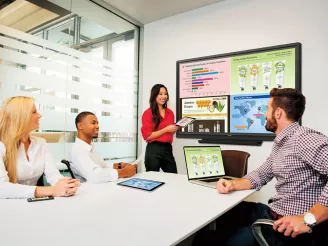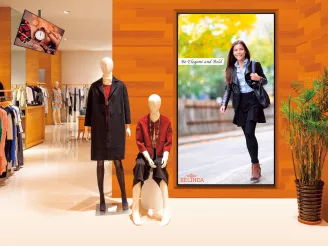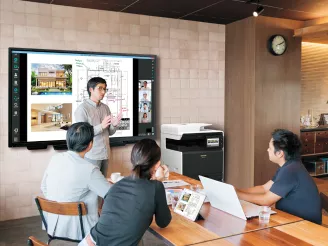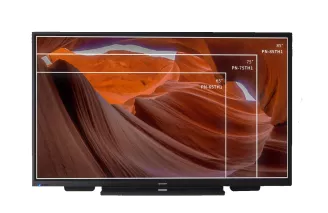Interactive Displays
What are interactive displays?
You may know them as touch screens and most likely use one every day.
From phones, tablets and laptops to large presentation boards, interactive display screens - no matter the size - are essentially computers that allow you to engage and collaborate in real-time and on-screen. Using advanced interactive display solutions combined with AV software and accessories, you simply use your fingertips or pen to touch, pinch, swipe up to shop, annotate, and sketch.

How are they different from digital signage?
The video walls, menu boards and signage used for static messaging and automated content need not be interactive. As a result, they can be much bigger - think theatre districts, city centre retail adverts and so on.
Interactive display boards and screens require engagement with the technology to deliver results - designed to support business presentations, interactive customer support such as maps and wayfinding, experiential marketing, and educational settings.

Technology built for the classroom to the boardroom
Students are more digitally savvy than ever. With most young people growing up as digital natives, schools and educational settings greatly benefit from the speed and intelligence that interactive display technology can deliver for both staff and students.
For people with additional needs, interactive displays offer a highly responsive touchscreen that is easier to use than a mouse and requires less space to do so, allowing them access to technology that was otherwise unavailable - enhancing engagement, learning and play.

It's all in the touch...
Projected Capacitive (P-CAP) touch technology is considered the premium technology that offers multi-user support of up to 30 point multi-touch, with an incredibly smooth response with minimal latency. On the other hand InfraRed (IR) touch technology can give 20 point multi-touch, and is a well trusted, lower cost option but still giving you a smooth, intuitive and responsive touch screen experience on interactive displays, with low latency or delay.
Multi-touch technology allows the interactive surface to recognise more than one point of contact, at the same time, and therefore allows gesture operations such as pinch, zoom and rotate as well as the chance for several users to use the screen at the same time. Interactive displays for business are perfect for delivering boardroom pitches, presentations and impressing in those all-important client meetings. They are quick, slick and provide a modern twist on the traditional meeting - no need to wait for the next slide or hunt for a pen.
Various software packages are available for business and education, enabling you to deliver your message and collaborate on work with style and ease.
Interactive and engaging...
Research shows that interactive content beats static displays in the race for customer engagement.
Interactive display systems are the ideal solution for experiential marketing and campaigns, allowing you to reach your customers directly, encouraging them to engage with your brand more quickly - and leaving a lasting impression.
From branded interactive maps to in-store trial sessions and field market research, interactive display solutions can set you apart from competitors.

Things to consider...
- Size - What are you displaying and where? From compact 43” screens for individual use and collaborative work through to 86” boardroom size screens, there is a size to suit you.
- Connectivity - Whether WIFI or fixed-line, ensuring your connectivity is up to standard ensures the dreaded buffer doesn’t appear mid-meeting. Team up with your content management system properly, and you are ready to present and collaborate.
- Sound & brightness - Increased brightness positively affects screen visibility, but consider signage location and your intended audience, too, especially in schools and Special Educational Needs (SEN) settings.
- Software - To ensure you get the best from your interactive display, there are many different software packages to suit specific needs. Whether you’re writing with digital pens directly onto on-screen documents or using touchscreen presentation software, systems are available as part of package deals and as individual purchases.
- Single touch vs multi-touch - How you want to use your screen will determine whether single or multi-touch functionality is best for you. Pinch-to-zoom is an everyday example of multi-touch; single touch is a simpler way to display information and collect data. An expert can help guide you through the options when you make your purchase.
Make an impact and get interactive with Sharp. Explore our AV equipment as well as AV software and accessories to find your perfect interactive display solution.

Explore our range of AV equipment
Choose from the options below


